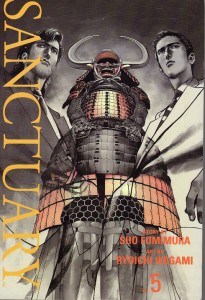Manga Review: Sanctuary Story by Sho Fumimura, Art by Ryoichi Ikegami
In the killing fields of Cambodia in the 1970s, two sons of Japanese expatriates helped each other survive and became blood brothers. When they were brought back to Japan, the boys were disgusted by how stagnant and corrupt Japanese society had become. They came up with a plan to reform Japan, a two-pronged attack through the Yakuza (Japanese organized crime) and the Diet (the Japanese parliament.) Which boy took which route was left to a game of rock paper scissors.
When we see them in the early 1990s, Akira Hojo is an underboss in the Kanto area (Tokyo and environs) of the Yakuza, while Chiaki Asami is a political advisor to a Dietman. They see their chances, and take them, Hojo taking over as boss of his gang, while Asami becomes a Dietman himself. Their relationship is a secret which allows them to support each other as they rise in their respective fields, always keeping the goal of a revitalized Japan in mind.
This political/crime thriller series has some great art by Ryoichi Ikegami (Mai the Psychic Girl, Japanese Spider-Man, Crying Freeman) which allows most of the main characters to be easily distinguishable from each other. The writer is otherwise known as Buronson, creator of Fist of the North Star. As you might expect from this combination, much time is spent on manly men mediating on what it means to truly be a man, doing manly things and shedding manly tears.
Unfortunately, this comes at the cost of having many female characters that are relevant to the story. Most of the women we see are lovers or victims of the men who move the plot (nudity makes this a mature readers title.) The most prominent female character is Deputy Police Chief Kyoko Ishihara, who rapidly winds up romantically involved with Hojo and fails to do much of anything police-like.
In the volume to hand, #5, Hojo spends most of his time recovering from being shot by a Chinese hitman hired by the Kobe area Yakuza. He isn’t even awake for the first third of the volume. Fortunately, he has able assistants who have his orders for just such a situation.
Thus the spotlight is on Asami and his “Rippu-Kai” (Rising Wind Association), an alliance of young and minority party Dietmen. Their plan is to reinvigorate Japan’s apathetic voter base by proposing an amendment to Japan’s Constitution, specifically Section Nine. This is the part that forbids Japan from having a standing military (with the Self-Defense Force being a dubiously justified kludge.) The young Dietmen don’t really care if the amendment passes, or in what form, but you can bet that the Japanese people would really care, have fierce debate, and get out the vote.
It’s at this point that Hojo’s arch-enemy becomes important. Norimoto Isaoka is the Secretary-General of the Liberal Democratic Party, which has had a virtual monopoly on power for decades. He realizes that if the Japanese public starts voting, that will upset the balance of power and all the connections he’s built up over the years. He knows where most of the bodies are buried, and decides that the constitutional amendment must never come up for a vote.
The Rising Wind realize that Isaoka is now their main obstacle, and try to bring him down with a corruption scandal, and that takes up most of the volume.
This is an interesting (if really skewed) look at the Japanese political and social climate in the early 1990s; it’s out of print in the U.S., but you can probably find the “flipped” Viz volumes relatively inexpensive on the used market.

